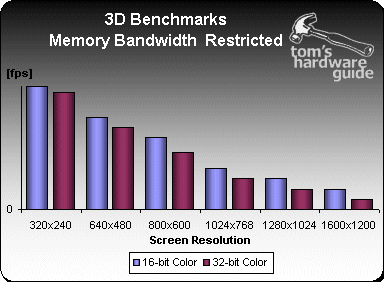3D Benchmarking - Understanding Frame Rate Scores
3. The Huge Impact Of The Memory Bandwidth, Continued
After you've seen how often the local memory needs to be accessed for each pixel, you can imagine why the impact of memory bandwidth on frame rates increases as screen resolution and color depth go up.
At low resolutions and 16-bit color the memory bandwidth doesn't usually limit the chip. However, even at only 16-bit color depth and high resolutions the memory bandwidth does already have a hefty impact on the frame rate, regardless how high the theoretical fill rate of the 3D-chip may be. Things get a lot worse at 32-bit color depth. You will see the frame rate almost halve wherever the memory bandwidth was already the bottleneck at 16-bit color. At 32-bit color the amount of data that needs to be transferred between the 3D-chip and the local memory doubles almost exactly. This is why the frame rates at 32-bit color are always lower than at 16-bit color, unless there is excess memory bandwidth at 16-bit color.
This important issue with memory bandwidth has to be kept in mind when reading the fill rates that are claimed for a chip. People who e.g. overclock a GeForce2 GTS chip to 250 MHz are telling you complete crap if they claim a fill rate of 1 Gpixel/s. For this fill rate GeForce2 GTS would require its memory to run at 600 MHz.
Get Tom's Hardware's best news and in-depth reviews, straight to your inbox.
Current page: 3. The Huge Impact Of The Memory Bandwidth, Continued
Prev Page 3. The Huge Impact Of The Memory Bandwidth Next Page Summary